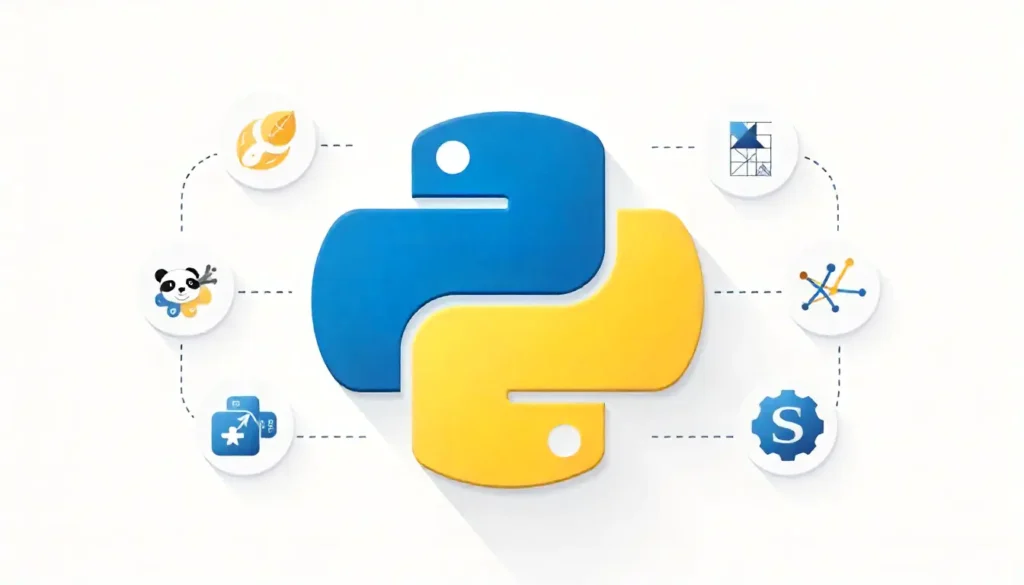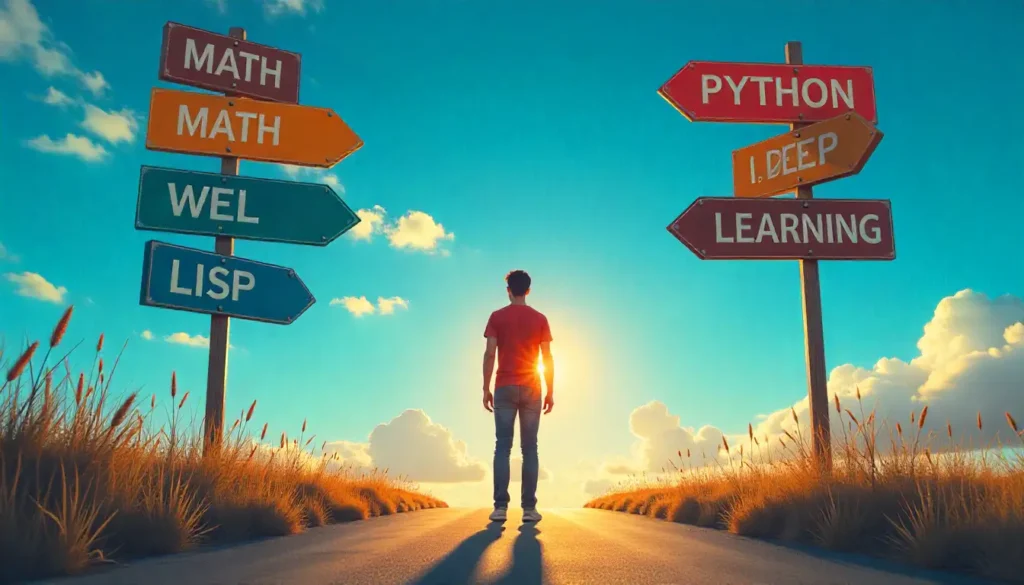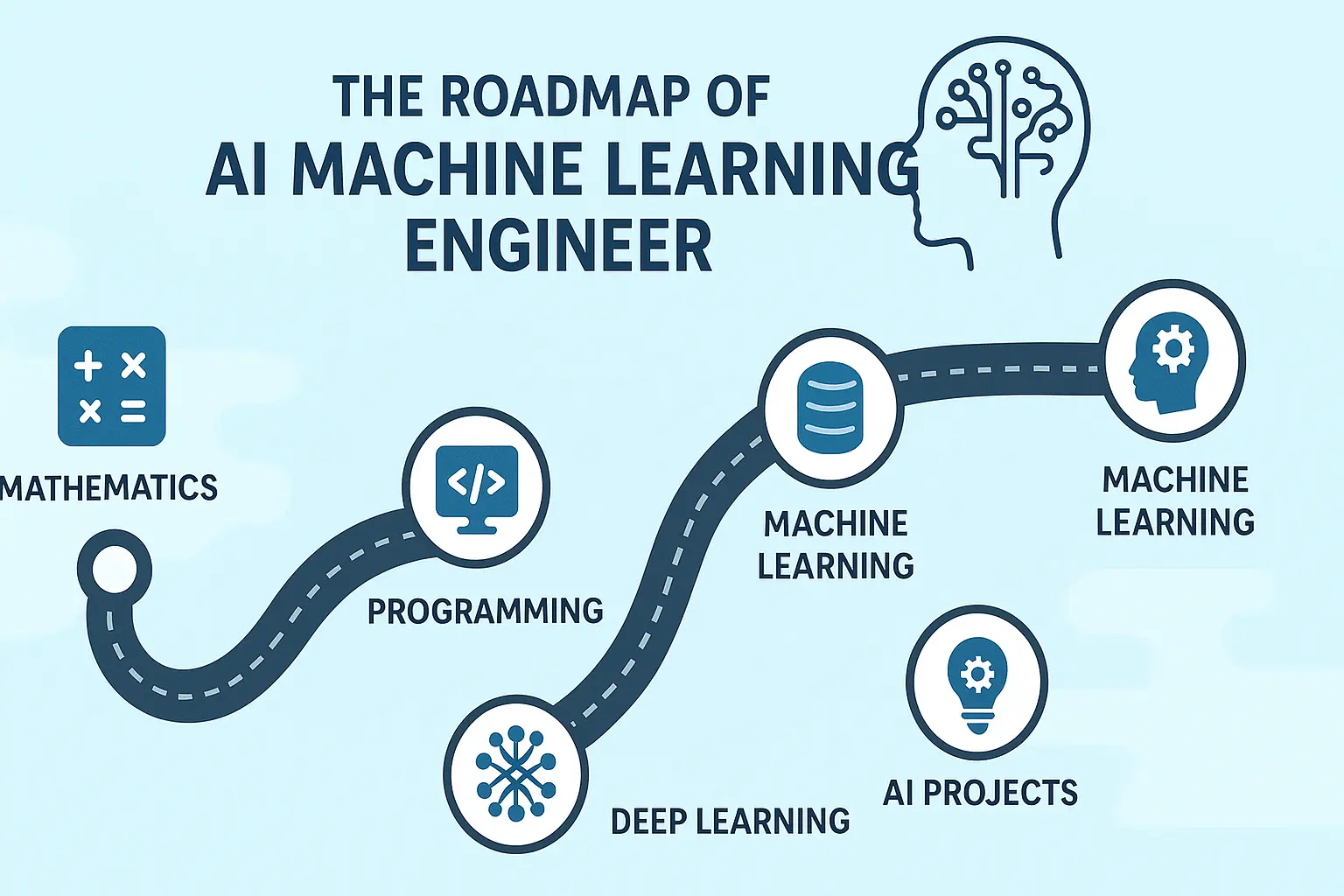A lot of individuals desire to be AI or machine learning engineers. It may seem like a complicated task, but when one has the right roadmap, everyone can strive to it. We will take it step by step.

Step 1: Master the Funds of Programming.
All AI machine learning engineers begin with code. The most popular one is Python. It is written in simple syntax, and machine learning can be supported by numerous libraries. You do not have to learn sophisticated coding initially. Target loops, functions, data types, and classes. Make minor projects, such as a calculator or a text-based game. This builds confidence.
Table of Contents
Step 2: Establish a Good Foundation in Math.
Machine learning lies in the core of math. Begin with high school level algebra and proceed to linear algebra, calculus and statistics. You do not have to solve complicated equations every day, but you should know the principles of algorithms. Indicatively, understand how calculus is used in gradient descent to change model weights. Study probability to be able to read patterns of data.

Step 3: Learn Data Handling
Machine learning is powered by data. You must know how to gather, clean and cook it. Get familiar with Python tools, such as Pandas and NumPy. Reading CSV files, elimination of missing values, and normalization of data. Build small datasets and exercise your skills. E.g. Clean a collection of movie ratings and discover average scores.
Step 4: Learn the Basics of Machine Learning.
Now comes the fun part. Unsupervised and supervised learning. Models in supervised learning take labeled data, such as house price prediction. In unsupervised learning, models discover latent patterns, such as classifying customers based on shopping behaviour.
Popular algorithms:
- Linear regression
- Logistic regression
- Decision trees
- K-means clustering
Run Scikit-learn, a Python library, which allows easy running of these models.
Step 5: Deep Learning and Neural Networks.
After knowing the fundamentals, progress to deep learning. The neural networks are imitations of the human brain. They are able to identify pictures, read or even compose music.

Begin with a feed-forward network. Get to know the flow of inputs across layers and the activation of neurons. Next switch to convolutional networks (CNNs) with image tasks and recurrent networks (RNNs) with sequence data such as text. These models are built and trained with TensorFlow or PyTorch.
Step 6: Study Tools and Frameworks.
A contemporary machine learning engineer who uses AI is supposed to be aware of appropriate tools. These frameworks are time saving and model building is simplified. Focus on:
- Scikit-learn exploratory models.
- Deep learning in TensorFlow.
- PyTorch to build flexible research and projects.
- Simple neural network Keras.
Also master version control with Git. It assists in monitoring the changes and exchange the code with others.
Step 7: Work on Projects
Without practice theory is useless. Begin working on actual projects. A few ideas:
- Naive Bayes Spam email detector.
- Collaborative filtering movie recommendation system.
- Image classifier using CNNs
- Twitter post sentiment analysis.
- Post your projects on GitHub. Recruiters are fond of working code.
Step 8: Understand Deployment
One needs more than to train a model. Businesses desire models that operate in manufacturing. Get to know how to implement your models as APIs. Work with such tools as Flask or FastAPI. Hack into cloud services such as AWS, GCP, or Azure. They are used by many companies to scale models.
As an example, create a little web application that forecasts house prices and deploy it to the Internet. This demonstrates that you know about modeling and deployment.
Step 9: Learn MLOps Basics
Machine learning operations are abbreviated as MLOps. It is a combination of coding, deployment, and monitoring. Models are updated with changing data. Study how to scale with such tools as Docker and Kubernetes. CI/CD pipelines to automate updates, learn too. This is a move that makes you stand out of the beginners.
Step 10: Continue Learning and being updated.
AI and machine learning evolve. Each year new tools and models are emerging. Subscribe to research articles, blogs, and YouTube channels. Compete with Kaggle to challenge your abilities. Be open-source learners. In this field growth is never ending.
Skills Beyond Coding
Technical skills are important, but soft skills are useful. Being an AI machine learning engineer, you should:
- Report findings in an understandable manner.
- Collaborate with developers and data scientists.
- Reflect on information and morality.
To illustrate, when a model is biased, you have to clarify the problem and correct it.
Career Path and Jobs
You can find numerous jobs with these skills:
- Machine Learning Engineer: Construct and implement models.
- Data Scientist: Data analysis and experiment design.
- AI Researcher: Develop new models and algorithms.
- MLOps Engineer: Scale machine learning systems.
- Wages are high, and the demand is growing all over the world.
Tips to Follow This Roadmap
- Learn in small steps. Don’t rush through topics.
- Exercise every day, even an hour.
- Projects of buildings, not theory notes.
- Get online communities to assist and comment.
- Be intrigued and explore new tools.
Final Thoughts
The roadmap of the AI machine learning engineer can seem a long one, but it is possible. Divide it into stages and continue constructing. Begin with Python, study math, learn machine learning, dive into deep learning, and proceed to deployment. Keep practicing and be up to date.
With consistency, you will be able to establish a good career in AI and machine learning.

Frequently Asked Questions For The Roadmap Of AI Machine Learning Engineer
Q1.What is the AI Machine Learning Engineer Roadmap?
It is a step-by-step tutorial that indicates the knowledge and the tools required to become an AI machine learning engineer.
Q2.Do I require good maths to begin machine learning?
Yes, you must have some algebra, statistics and calculus, but you do not need to be a genius.
Q3.What is the first program language that I need to learn?
The easiest place to start is Python since it is easy and has numerous machine learning packages.
Q4.What can I do to train machine learning skills?
Code on GitHub, compete on Kaggle, and work on small projects.


2 thoughts on “The Roadmap Of AI Machine Learning Engineer”